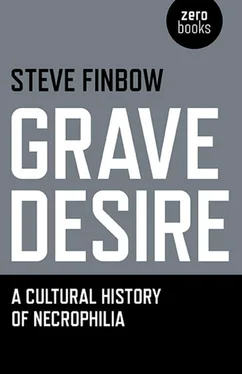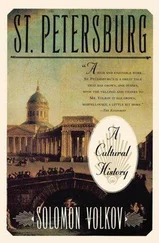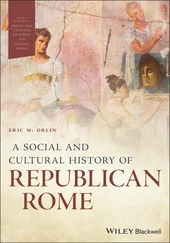The corpse—or work of art—a polluted object, which, when viewed is sublimated in its observation, where necrophilia incorporates scopophilia, becomes the vision of beauty in excess. Bataille writes about Gilles de Rais: ‘His crimes responded to the immense disorder which inflamed him, and in which he was lost. We even know, by means of the criminal’s confession, which the scribes of the court copied down whilst listening to him, that it was not pleasure that was essential. Certainly he sat astride the chest of the victim and in that fashion, playing with himself [se maniant], he would spill his sperm upon the dying one; but what was important to him was less sexual enjoyment than the vision of death at work. He loved to look: opening a body, cutting a throat, detaching limbs, he loved the sight of blood.’ [6] Quoted in Nick Land, The Thirst for Annihilation, Georges Bataille and Virulent Nihilism (London, 1992), p. 49.
In his poem ‘Paisant Chronicle,’ Wallace Stevens writes, ‘What it seems / It is and in such seeming all things are.’ [7] Wallace Stevens, The Collected Poems (New York, 1982), p. 339.
Meret Oppenheim’s Object (Paris, 1936) is what it seems—a fur-covered saucer, cup, and teaspoon. What is happening here? The everyday objects we use to consume our oxtail soup and our crème brûlée are fetishized. The fur covering sexualizes the object-in-itself—its new pelt subsumes its very usefulness, its readiness-to-hand. It is transformed from a tool into a sexual object, one of disgust—the thought of fur on our tongues, hairs stuck to the back of our throat, lodged in our oesophagus. Yet, Object is also a thing of beauty—the luxurious fur of the Chinese gazelle inviting us to stroke it, the smooth curvilinear architecture of the cup, saucer, and spoon like hypermodern air terminals and airplanes streamlined by hunter-gathering Cro-Magnons; or cars and their eroticized speed deaths, the sexual thrust of the body and its encompassing prosthesis: ‘Trying to exhaust himself, Vaughan devised an endless almanac of terrifying wounds and insane collisions: The lungs of elderly men punctured by door-handles; the chests of young women impaled on steering-columns; the cheek of handsome youths torn on the chromium latches of quarter-lights. To Vaughan, these wounds formed the key to a new sexuality, born from a perverse technology. The images of these wounds hung in the gallery of his mind, like exhibits in the museum of a slaughterhouse.’ [8] J.G. Ballard, Crash, (London, 2008), p. 6.
Almost as if Ballard were rewriting the Second Futurist Manifesto: ‘We declare that the splendour of the world has been enriched by a new beauty—the beauty of speed. A racing car with its bonnet draped with exhaust-pipes like fire-breathing serpents—a roaring racing car, rattling along like a machine gun, is more beautiful than the winged victory of Samothrace’ [9] F.T. Marinetti, Critical Writings, trans. Doug Thompson (New York, 2006), p. 13.
as: ‘We declare that the splendour of the world has been enriched by a new beauty—the beauty of death. A racing car with its bonnet draped with genitalia like fire-breathing serpents—an eroticized corpse, rattling along in its death throes, is more beautiful than the crucified body of Jesus Christ.’
Object is an object of desire subject to detestation, of taste subject to distaste, of pleasure subject to pain. Its concave surfaces suggest female sexual organs—it is fiercely anti-masculine, surprisingly political, an inward turning of all those up-thrusting phalluses created by Picasso and Brancusi. ‘Very soft particles—but also very hard and obstinate, irreducible, indomitable.’ [10] A Thousand Plateaus: Capitalism and Schizophrenia, p. 276.
A quotidian object consumed by the sexual gaze of its observer, revulsion overcome by compulsion, rejection by fascination. Object destabilizes the phenomenological presentation of everyday objects; defamiliarized in their own appearance of appearance, they question our very being. Meret Oppenheim’s Object reifies Heidegger’s description of phenomena as ‘that which shows itself in itself. The manifest.’ [11] Heidegger, Martin, Being and Time, trans. John Macquarrie and Edward Robinson (New York, 1962), p. 51.
Is a human body ever reducible to a thing? When does s/he become it? ‘The object is an imperative, radiating over us like a black sun, holding us in its orbit, demanding our attention, insisting that we reorganize our lives along its axes. The object is a force, and thus our valuation of it is a gift of force, and nothing like a recognition at all.’ [12] Graham Harman, Towards Speculative Realism (Ropley, Hants, 2010), p. 20.
No matter which way you look at them, they look wrong. A head does not seem to fit the body to which it is attached, the legs are not where legs should be, the intagliated pudenda appears alien, distended sockets and dislocated limbs sprout from elongated or truncated torsos. The skin on some of them looks as though it is made from bone, and the bone looks like it’s crafted from flesh. ‘These flaccid globes, like the obscene sculptures of Bellmer, reminded her of elements of her own body transformed into a series of imaginary sexual organs. She touched the pallid neoprene, marking the vents and folds with a broken nail. In some weird way they would coalesce, giving birth to deformed sections of her lips and armpit, the junction of thigh and perineum.’ [13] J.G. Ballard, The Atrocity Exhibition (Revised edition: London, 2006), p. 82.
Some have the faces of young virgins, others resemble department store mannequins, while still more have no heads at all. Most of the bodies are de-articulated, fragmented. Joined at the navel and reversed—the body has two sets of legs, an anus and a hairless vagina where, logically, the head should be. ‘In his eye, without thinking, he married her right knee and left breast, ankle and perineum, armpit and buttock.’ [14] The Atrocity Exhibition, p. 92.
Another, tied to a banister, is armless, one-legged, the pre-pubescent pudenda juxtaposed against the buttocks as breasts. Where are its arms? What happened to one of its legs? The absence of body parts becomes pure presence through the abject bondage: ‘the bodily self is phenomenally represented as inhabiting a volume in space, whereas the seeing self is an extensionless point—namely, the center of projection for our visuospatial perspective, the geometrical origin of our perspectival visual model of reality. Normally this point of origin (behind the eyes, as if a little person were looking out of them as one looks out a window) is within the volume defined by the felt bodily self. Yet, as our experiments demonstrated, seeing and bodily self can be separated, and the fundamental sense of selfhood is found at the location of the visual body representation.’ [15] Thomas Metzinger, The Ego Tunnel: the science of the mind and the myth of the self (New York, 2009), pp. 100-101.
Some might be wearing masks, have leg stumps for a brow, labia for a mouth. Childhood objects surround these figures of erotic amputation, of nightmare assemblage. White ankle socks and patent-leather shoes, blonde locks and pink bows. These mutilated figures are from Hans Bellmer’s Doll series originating in 1934 with the publication of Die Puppe, ten black and white photographs of the assembled (or disassembled) doll in various provocative poses. ‘They must not be opposed determinations of the same of a same entity, nor the differentiations of a single being, such as the masculine and the feminine in the human sex, but different or really-distinct things ( des réellement distincts ), distinct ‘beings,’ as found in the dispersion of the nonhuman sex, the clover and the bee).’ [16] Gilles Deleuze and Félix Guattari, p. 356.
Читать дальше












